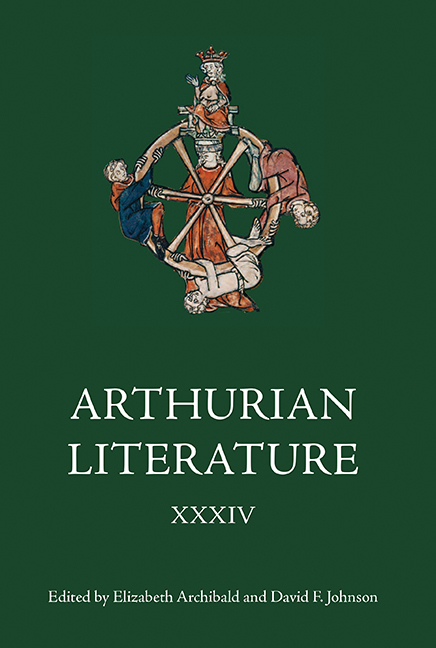Book contents
- Frontmatter
- Contents
- List of Illustrations
- General Editors’ Foreword
- List of Contributors
- I Illusory Ends in Chrétien de Troyes’ Erec et Enide
- II Who is the Traitor at the Beginning of Sir Gawain and the Green Knight?
- III Sir Gawain's Death and Prophecy in Malory's Morte Darthur
- IV Late Medieval Irish Kingship, Egerton 1782, and the Irish Arthurian Romance Eachtra an Mhadra Mhaoil (‘The Story of the Crop-Eared Dog’)
- V ‘Which I have beholden with most curiouse eyes’: The Lead Cross from Glastonbury abbey
- VI The Arundel Coronatio Arthuri: A Middle English Sword in the Stone Story from London, College of Arms MS Arundel 58
- Arundel Coronacio Arthuri
- Appendix I Linguistic Profile For Aca
- Appendix II Select Glossary
- Contents of Previous Volumes
V - ‘Which I have beholden with most curiouse eyes’: The Lead Cross from Glastonbury abbey
Published online by Cambridge University Press: 17 July 2019
- Frontmatter
- Contents
- List of Illustrations
- General Editors’ Foreword
- List of Contributors
- I Illusory Ends in Chrétien de Troyes’ Erec et Enide
- II Who is the Traitor at the Beginning of Sir Gawain and the Green Knight?
- III Sir Gawain's Death and Prophecy in Malory's Morte Darthur
- IV Late Medieval Irish Kingship, Egerton 1782, and the Irish Arthurian Romance Eachtra an Mhadra Mhaoil (‘The Story of the Crop-Eared Dog’)
- V ‘Which I have beholden with most curiouse eyes’: The Lead Cross from Glastonbury abbey
- VI The Arundel Coronatio Arthuri: A Middle English Sword in the Stone Story from London, College of Arms MS Arundel 58
- Arundel Coronacio Arthuri
- Appendix I Linguistic Profile For Aca
- Appendix II Select Glossary
- Contents of Previous Volumes
Summary
The lead cross supposedly found in the grave of King Arthur at Glastonbury Abbey is an icon of Arthurian studies (Figure 1). Its likeness, first published in William Camden's Britannia in 1607, reappeared in all subsequent editions of that widely read and influential survey, in derivative works including John Speed's History of Great Britaine (1611) and Jan Jansson's Novus Atlas (1646), in manuscripts such as Thomas Dineley's report of the 1684 progress of the Duke of Beaufort through Wales, and in countless publications, scholarly and popular, since. Only a minority of commentators would now champion the cross as a genuine relic of the historical Arthur, but even as a pious – or not so pious – medieval fake it may still have much to tell us about his cult. However, although it has been the subject of considerable speculation and debate, few firm conclusions have been drawn, and pertinent points have sometimes been buried within broader considerations of Arthurianism or Glastonbury. Moreover, in the absence of either the artefact itself or any alternative graphic source, the accuracy and authority of Camden's woodcut have been subject to relatively little critical scrutiny.
The present investigation sets out to reassess what we know and do not know about the object, its ‘discovery’, its purpose and its fate, to consider more closely the status of the woodcut and to take account of an important new piece of evidence, a hitherto overlooked variant drawing. It argues that both woodcut and drawing were based (not entirely reliably) on a sketch made by John Leland in the 1530s, now lost; and lends some support to the view that the cross itself was a monastic forgery of the late twelfth century. It also raises the possibility, however, that there was more than one cross, and that the item recorded by Leland and Camden may have been a late medieval replacement for the ‘original’.
The Discovery
The lead cross lay at the heart of what James Carley has highlighted as ‘perhaps the single most important event’ in Glastonbury's history: the recovery by the monks of Arthur's remains from their burial place next to the abbey church.
- Type
- Chapter
- Information
- Arthurian Literature , pp. 88 - 129Publisher: Boydell & BrewerPrint publication year: 2018



